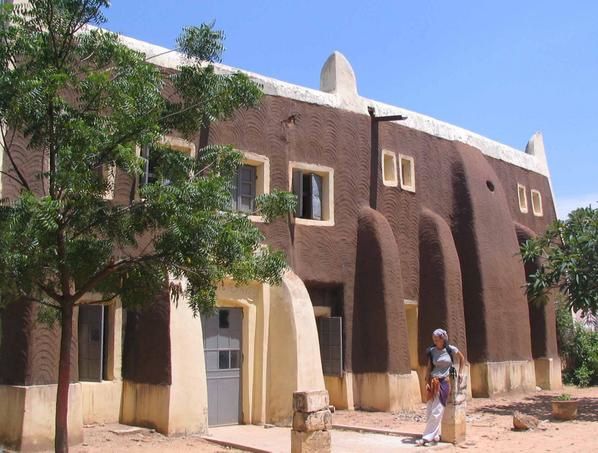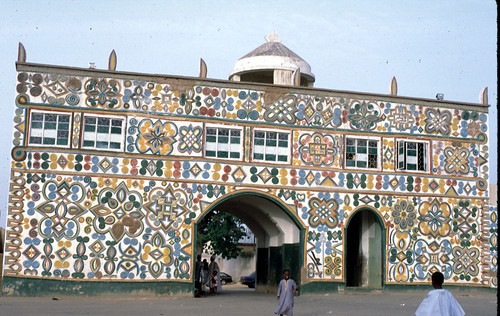Brief Description
 The dense forest of the Osun Sacred Grove, on the outskirts of the city of Osogbo, is one of the last remnants of primary high forest in southern Nigeria. Regarded as the abode of the goddess of fertility Osun, one of the pantheon of Yoruba gods, the landscape of the grove and its meandering river is dotted with sanctuaries and shrines, sculptures and art works in honor of Osun and other deities. The sacred grove, which is now seen as a symbol of identity for all Yoruba people, is probably the last in Yoruba culture. It testifies to the once widespread practice of establishing sacred groves outside all settlements. Statement of Significance
The dense forest of the Osun Sacred Grove, on the outskirts of the city of Osogbo, is one of the last remnants of primary high forest in southern Nigeria. Regarded as the abode of the goddess of fertility Osun, one of the pantheon of Yoruba gods, the landscape of the grove and its meandering river is dotted with sanctuaries and shrines, sculptures and art works in honor of Osun and other deities. The sacred grove, which is now seen as a symbol of identity for all Yoruba people, is probably the last in Yoruba culture. It testifies to the once widespread practice of establishing sacred groves outside all settlements. Statement of SignificanceCriterion (iii): The Osun Sacred Grove is the largest and perhaps the only remaining example of a once widespread phenomenon that used to characterise every Yoruba settlement. It now represents Yoruba sacred groves and their reflection of Yoruba cosmology.
Criterion (vi): The Osun Grove is a tangible expression of Yoruba divinatory and cosmological systems; its annual festival is a living thriving and evolving response to Yoruba beliefs in the bond between people, their ruler and the Osun goddess.
Long Description
The Osun Sacred Grove is the largest and perhaps the only remaining example of a once widespread phenomenon that used to characterise every Yoruba settlement. It now represents Yoruba sacred groves and their reflection of Yoruba cosmology. It is a tangible expression of Yoruba divinatory and cosmological systems; its annual festival is a living thriving and evolving response to Yoruba beliefs in the bond between people, their ruler and the Osun goddess.The grove covers 75 ha of ring-fenced forest alongside the Osun River on the outskirts of Osogbo town, Western Nigeria. About 2 million people live in Osogbo. The grove in Yoruba cosmology is the domicile of Osun, the goddess of fertility. Ritual paths lead devotees to 40 shrines, dedicated to Osun and other Yoruba deities, and to nine specific worship points beside the river. Osun is the Yoruba personification of the 'waters of life' and the spiritual mother of the Osogbo township. It also symbolizes a pact between Larooye, the founder of Osogbo, and Osun: the goddess gave prosperity and protection to her people if they built a shrine to her and respected the sprit of the forest. Unlike other Yoruba towns whose sacred groves have atrophied, or disappeared, the Osogbo Grove has, over the past 40 years, been re-established as a central, living focus of the town. The Osogbo Grove is now seen as a symbol of identity for all Yoruba people, including those of the African diaspora, many of whom make pilgrimages to the annual festival.
The grove has a mature, reasonably undisturbed, forest canopy, which supports a rich and diverse flora and fauna - including the endangered white-throated monkey. Some parts were cleared in the colonial period, and teak plantations and agriculture introduced, but these are now being re-established. The grove is a highly sacred sanctuary where shrines, sculptures and artworks honour Osun and other Yoruba deities. It has five main sacred divisions associated with different gods and cults, located either side of a path transecting the grove from north-west to south-east.
The Osun River meanders through the whole grove and along its length are nine worship points. Throughout the grove the broad river is overhung with forest trees. Its waters signify a relationship between nature, the spirits and human beings, reflecting the place given to water in the Yoruba cosmology as symbolizing life. The river is believed to have healing, protective and fertility powers. The fish are said to have been used by the goddess Osun as messengers of peace, blessings and favour.
Traditionally, sacred trees and stones and metal objects, along with mud and wood sculptures, defined the deities in the grove. During the past 40 years, new sculptures have been erected in the place of old ones and giant, immovable ones created in threatened spaces in the grove by Suzanne Wenger working with a group of local artists called New Sacred Art. These sculptures are made from a variety of materials - stone, wood, iron and concrete. There are also wall paintings and decorative roofs made from palm fronds.
There are two palaces. The first is part of the main Osun-Osogbo shrine. The second palace is where Larooye moved to before the community established a new settlement outside the grove. Both buildings are constructed of mud walls with tin roofs supported variously by mud and carved wooden pillars. The three Ogboni buildings are constructed with sweeping roofs rising high over the entrances and supported on a cluster of slender carved wooden posts.
The Annual Osun-Osogbo festival is a 12-day event held once a year at the end of July and the beginning of August. The grove is seen as the repository of kingship, as well as the spiritual heart of the community. The festival invokes the spirits of the ancestor kings and rededicates the present Oba to Osun, as well as reaffirming and renewing the bonds between the deities represented in the Sacred Grove and the people of Osogbo. The finale of the festival is a procession of the whole population, led by the votary maid Arugba and headed by the Oba and priests, all accompanied by drumming, singing and dancing.
Source: UNESCO/CLT/WHC
Historical Description
The town of Osogbo is believed to have been founded around 400 years ago. It is part of the wider Yoruba community, divided into 16 kingdoms, which legend says were ruled by the children of Oduduwa, the mythic founder, whose abode at Ile-Ife, south-east of Osogbo, is still regarded as the spiritual home of the Yoruba people.The earliest settlement seems to have been in the Osogbo Grove and included palaces and a market. When the population expanded the community moved outside the Grove and created a new town, which reflected spatially the arrangements within the Grove.
In the 1840s Osogbo became a refugee town for people fleeing the Fulani Jihad, as it moved south from what is now northern Nigeria. The Yorubas retreated further south into the forests and Osogbo, right at the northern edge of the forest, became an important centre for northern Yorubaland.
The Fulani attacks on Osogbo were repelled and, as a result, Osogbo has become a symbol of pride for all the Yorubas.
During the first half of the 20th century, the town of Osogbo expanded considerably. In 1914 British colonial rule begun. As it was delivered under a system of indirect rule through traditional rulers, the authority of the Oba and priests were sustained. A greater change was brought about from the middle of the 19th century through the introduction of both Islam and Christianity. Islam became the religion of traders and ruling houses - as it gave contacts to northern trade routes and links to returning exslaves from Central and South America. For a while all three religions co-existed but as time went by it became less fashionable to be identified with the Ogboni and Osun cults.
By the 1950s the combined political and religious changes were having a marked detrimental effect on the Grove: customary responsibilities and sanctions were weakening, shrines were becoming neglected and traditional priests began to disappear. All this was exacerbated by a rise in the looting of statues and movable sculptures to feed an antiquities market. At around this time part of the Grove was acquired by the Department of Agriculture and Forestry for agricultural experiments. Trees were felled and teak plantations established; sculptures were reportedly stolen and hunting and fishing begun to be recorded - previously forbidden in the sacred Grove.
It was at this crucial point in the history of the Grove that Austrian born Suzanne Wenger moved to Osogbo and, with the encouragement of the Oba and the support from local people, formed the New Sacred Art movement to challenge land speculators, repel poachers, protect shrines and begin the long process of bringing the sacred place back to life through once again establishing it as the sacred heart of Osogbo.
The artists deliberately created large, heavy and fixed sculptures in iron, cement and mud, as opposed to the smaller traditional wooden ones, in order that their intimidatory architectural forms would help to protect the Grove and stop thefts. All the sculptures have been done in full respect for the spirit of the place, with inspiration from Yoruba mythology and in consultations with the gods in a traditional context.
The new work has made the Grove a symbol of identity for the Yoruba people. Many from the African Diaspora now undertake a pilgrimage to the annual festival.
In 1965 part of the Grove was declared a national monument. This was extended in 1992 so that now the whole 75 hectares are protected.

 - - Arugba carrying the calabash of sacrifice, covered with a big red robe at the grove
- - Arugba carrying the calabash of sacrifice, covered with a big red robe at the grove 












 – Arugba- The Votary Maid who carries the calabash of sacrifice to the Osun grove
– Arugba- The Votary Maid who carries the calabash of sacrifice to the Osun grove 








